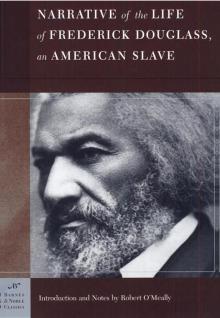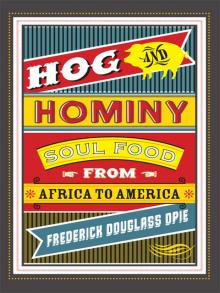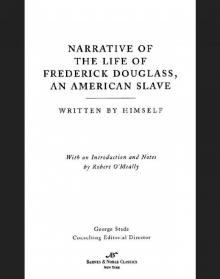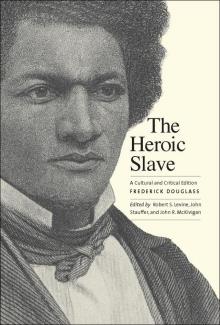- Home
- Frederick Douglass
Hog and Hominy: Soul Food From Africa to America Page 11
Hog and Hominy: Soul Food From Africa to America Read online
Page 11
Migrants from the South introduced southern traditions to African Americans born up north. Lucy Opie, for example, taught her northern-born grandchildren to carry box lunches when they traveled and to enjoy peach cobbler and mincemeat and rhubarb pies. Mincemeat and rhubarb pies were exotic alternatives to those made with apples that her grandchildren were accustomed to eating as New Yorkers raised in the apple-rich Hudson Valley region. After a couple of slices accompanied by a tall glass of cold milk, they grew to love them. In fact, they recall getting excited about going to Grandma Opie’s house as children during the holiday season because her southern hospitality meant she would always offer something sweet like a slice of pie or cake served with a scoop of homemade vanilla ice cream.
SPECIAL OCCASIONS: CHRISTMAS, WATCH NIGHT, AND HOMECOMING
Christmas for African Americans has traditionally been a very special holiday centered on sweets and offerings like chicken, ham, and a tableful of complementary side dishes. For those without much, Christmas might have meant little more than killing a chicken for dinner. Those in better financial condition celebrated with an assortment of meats and sweets such as “cakes, succulent pies, and luscious puddings.”60
Ruth and Roy Miller, whose parents migrated north in the 1920s, shared with me their memories of holiday cuisine. Ruth was born in Harlem in 1932. Her mother migrated there from Savannah, Georgia; she worked as a professional cook. Ruth has vivid memories of her mother’s holiday cooking. “We would have chicken and dumplings. We would have macaroni and cheese. We would have. . . sometimes cabbage with some smoked meat; collard greens, actually many times all of the greens would be combined: collards, kale, turnips; candied sweet potatoes; and many times red rice, okra, and tomatoes. . . . We would have spareribs with cabbage and sweet potatoes.” Roy Miller, born in Harlem in 1924, said, “That’s interesting because that’s a crossover. Because my [West Indian] aunts used to do red rice and all of that. I can’t say that is a purely West Indian dish, it may be part of an assimilation. . . . It emanated from the South, but my aunts used to do that beautifully also.”61
Dessert was a celebrated part of the holiday menu. For dessert, “my mother made banana pudding, sweet potato pie, you know, apple pie, lemon meringue pie, and cakes,” said Ruth Miller. West Indians made fruitcake, which was also traditional among southerners. Clara Bullard Pittman was born in 1948 in the very rural farming community of Pine-hurst, Georgia. She recalls that on Christmas her mother made homemade fruitcake from what she grew in her yard. She also made “cakes and pies from scratch.”62 Making Christmas fruitcake was a long process, according to Benjamin Outlaw. When asked what Christmas was like growing up in Windsor, North Carolina, Outlaw responded, “Oh boy, it was like heaven.” Mother “would start cooking her fruitcake, sometime about a month before Christmas. And she always made [either apple or grape] wine” and poured the “wine on the cake until Christmas. . . building it up. . . . It was the best fruitcake I have ever eaten.” Hattie Outlaw also made “all kinds of cakes: chocolate, vanilla, coconut, lemon.” He went on to say, “Now Christmas was wonderful, she had everything you could mention, all kinds of meats.” In addition, the family ate all kinds of vegetables at Christmas because the family raised their own vegetables, and “during the summertime she put that stuff up in a jar . . . butter beans, snap beans, corn.”63
On Christmas in Blaney, South Carolina, Nora Burns White recalled, “we always had a ham, you know, because we raised pigs.” They also had “all kinds of cakes, that’s when my mother would do some cooking because she would do some baking about a week before Christmas.”64 In Charlotte County, Virginia, Yemaja Jubilee’s mother always made lemon icebox pies for Christmas. “She made it out of condensed Carnation milk, vanilla wafers: she’d squeeze fresh lemon juice in it, egg whites, sugar, and butter and she would cream that up and put it inside a vanilla wafer crust. . . . She did all this from scratch,” says Jubilee, except for the vanilla wafers. It was called icebox pie “because you have to put it in the refrigerator for it to chill.” The pie was only made on special occasions like Christmas. In addition to dessert, her mother also cooked capons for Christmas. A lady who lived down the street raised them. Jubilee’s mother would stuff and bake them “the same way you did a turkey. . . the regular roosters were tough . . . but capons were tender and flavorful.” Jubilee adds, “We always had ham on Christmas and Thanksgiving.”65
In Virginia, Nettie Banks grew up with the tradition of eating pork and poultry on Christmas. If there was a ham left over from a hog-killing day earlier in the winter, her mother would boil that, and it would become a part of the Christmas feast. “Then they would have roast chicken. We didn’t do a lot with turkey. . . people didn’t have turkeys. My grandmother raised turkeys but we did not ordinarily have turkeys. We would have what they called fowl. And they would boil that then put it in the oven and baste it and bake it some. It was nice and brown.” Before she migrated north in 1938, she recalled eating chitlins on Christmas if there were any leftover from hog killing. “You know they would make whatever was available.”66
For Reginald T. Ward, Christmas in the city of Robinsonville, North Carolina, was similar to Christmas at Nettie Banks’s home. Christmas meant ham, turkey or chicken, and barbecue, “chopped barbecue.” Ward left North Carolina right after high school to attend the University of California at Los Angeles and later settled in the city of Mount Vernon, in Westchester County, New York. He explained that barbecue in New York meant barbecued ribs or chicken, “but in North Carolina barbecue, a whole pig is barbecued, cooked, and they chop it up with the different spices in it like vinegar and red pepper.” At Christmas, Ward’s mother would also make “oyster dressing” from leftover corn bread and bread, oysters, celery, onions, salt and pepper. “And some made sausage dressing.”67
Joyce White recalled that for Christmas dinner in Choctaw County, Alabama, her mother “roasted fresh pork and made corn bread dressing, potato salad, and greens.”68 (Duke University’s Stephen Erwin argued that collard greens were best when one ate them southern style. “It helps a great deal if one has pepper vinegar to sprink[le] over the collards before eating them and corn pone and fresh pork make collards a delight to eat.”)69 Joyce White’s Christmas in Alabama would be filled with the “warming aroma of Chicken ’n’ Dumplings, which was made with a big hen, since we seldom had turkey.” Often her mother would “simmer the hen whole and then bake it in the oven with the corn bread, and that was our ‘turkey,’” reflected White.70
WATCH NIGHT
Another African American southern religious tradition that should be mentioned is the Watch Night, or New Year’s Eve service. Watch Night dates back to the end of the Civil War. In 1862 President Abraham Lincoln declared his famous Emancipation Proclamation, which set slaves in Confederate territories free as of January 1, 1863. As a result, African Americans across much of the South held religious services, many of them secretly, in which they praised and otherwise worshipped God as they watched the New Year and freedom arrive. Thus after 1863 African Americans regularly celebrated Watch Night and New Year’s Eve in honor of Emancipation Day. Southerners carried their religious traditions with them when they migrated north.71
St. Clair Drake and Horace R. Cayton hold that the religious traditions of the rural South were “modified by contact with the complexities of a large northern city.”72 Yet southern migrants did not abandon their tradition of church membership. By 1945 the South Side of Chicago had about five hundred African American churches: “To the uninitiated, this plethora of churches is no less baffling than the bewildering variety and the colorful extravagance of the names. Nowhere else in Midwest Metropolis could one find, within a stone’s throw of one another, a Hebrew Baptist Church, a Baptized Believer’s Holiness Church, a Universal Union Independent, a Church of Love and Faith, a Holy Mt. Zion Methodist Episcopal Independent, and a United Pentecostal Holiness Church. Or a cluster such as St. John’s Christian Spiritual, Park Mission African Methodis
t Episcopal, Philadelphia Baptist, Little Rock Baptist, and the Aryan Full Gospel Mission, Spiritualist.”73
In addition to church membership, southern migrants brought with them a tradition of important yearly church programs and free food. Most likely to include free food were services on special occasions such as Easter, Thanksgiving, Christmas, and Watch Night. “In addition to these Christian red-letter days,” report Drake and Cayton, “Baptisms, anniversaries, installations [of new ministers], youth nights, and choir nights” were well-attended yearly programs where down-home southern cooking was available in abundance for free.74 In Chicago it was “not unusual to find a total of over 10,000 people attending” an important event at the four largest churches, and “an equal number distributed among the smaller churches.” African American churches in Chicago continually offered “concerts, pageants, plays, suppers, and other similar activities.”75
As in the South, one of the most important events of the year was Watch Night service on New Year’s Eve. This southern tradition had people filling church pews as early as 6:45 P.M. to secure a seat for a 7:00 P.M. Watch Night service at any of the five largest African American churches in Chicago. During the service the congregation sang hymns, listened to choirs, prayed, and worshipped until midnight. Then came an important part of the Watch Night service: the feast that followed the arrival of the New Year. Just after midnight, the members of the hospitality committee—the wives of the church—slipped into the kitchen to heat up food and then arrange it on the table of the fellowship hall, generally located in the basement or on the second floor of a church.
Frances Warren noted that, during her childhood, most families in the South ate black-eyed peas (cowpeas common to Igboland) and rice, especially at midnight on New Year’s. For an unknown reason, some southerners believed “it was good luck.” Warren was born in Atlanta in 1928 but spent most of her childhood in Miami, Florida. Her husband, Jim, grew up on a farm not far from Birmingham, Alabama, where blacks and whites followed the same New Year’s eating traditions. Born in 1925, Jim believed that the black-eyed peas and rice on New Year’s tradition had something to do with the influence of “black culture,” but he was not exactly sure where the practice originated.76 North Carolinian Reginald Ward said, “I don’t care where you are, in New York” black folk on New Year’s Day are going to eat “strictly pork.” Tradition calls for cooking “black-eyed peas, hog head, a whole hog head now, pig tails, pigs feet.” Ward went on to say, “You can go just about anywhere, and people who were born in the South, Georgia, Alabama, Mississippi, North Carolina, Tennessee,” cook pork on New Year’s Day.77
Having lived in California in the 1960s, Ward noticed that, “everybody born in the South was looking for pork” on New Year’s. As a result, the price of smoked and pickled pork parts like pigs’ feet and hog maws in California supermarkets became expensive around New Year’s. Ward reported that pork, collard greens, and black-eyed peas seasoned with smoked or salt pork, along with “potato salad, candied yams, macaroni and cheese, and corn bread” were traditional dishes that southern black folk around the country ate on New Year’s.78
A child of white southerners, Jim Warren was raised on the same type of southern cooking. He recalled that during the Depression that he would share meals with black farmhands at his family’s farm in Alabama. In the process, he learned that his mother shared the same cooking traditions as black women. These traditions included those like New Year’s dinners complete with black-eyed peas and rice, beans and greens cooked with ham hocks, and sweet potato pie.79
On New Year’s, Yemaja Jubilee’s mother oven-roasted a whole, hickory wood–smoked hog’s head and prepared black-eyed peas. She explains, “We raised hogs, and when they harvested the pig they would put the head down in salt [for about six weeks] and then they’d smoke it.” In Charlotte County, Virginia, “where I was raised, most of the people ate that or some kind of pork” on New Year’s.80
Southern superstition established the tradition of serving hopping John in addition to other traditional dishes that depended on where the southern migrant community was from. Hopping John is a combination of black-eyed peas and rice, beans, red peppers, and salt pork cooked to a stewlike consistency. It is probable that the dish evolved out of the rice and bean mixtures such as dab-a-dab, the rice, beans, vegetables, meat, palm oil, and pepper dish that West African slaves survived on during the Middle Passage.81 “On New Year’s Day,” in Virginia, recalled Lamenta Crouch, “we always had black-eyed peas and some kind of greens” along with “ham hocks or country ham.” “Country ham” refers to the type of ham typically cooked on Christmas, “smoked ham, what they called the good old Virginia hams.”82 In Bertie County in northeastern North Carolina, Hattie Outlaw prepared her New Year’s Day meal on the sixth of January, which she called “old Christmas.” What is noteworthy here is that Hattie Outlaw’s menu did not include pork. “Mama would make roast chicken, collard greens, desserts, and stuff like that,” recalls her son, Benjamin Outlaw.83
HOMECOMING
After the start of the Great Migration in 1914, most southern-born African Americans who left for the North referred to revivals down South as “homecoming week.” For instance, after moving up north, Joyce White, raised in Choctaw County, Alabama, recalled how “many of the people who had left our county years before would mark their return home by the revival at such and such church.”84 Churches typically held revivals in July and August after farmers had harvested their crops, when people had an abundance of food, money, and time for leisure. “I remember homecomings quite clearly” said Marcellas C. D. Barksdale, born in 1943 in Annandale, South Carolina. “My mother was a churchgoer and she would drag me [along], especially to the big events. We had the homecoming, pastor’s anniversary, Easter program, and all of them were social as well as cultural and religious programs.” He adds, “More often than not, when they had those big occasions, they would have these big eatings, as I called it. All the members would bring food, sometimes they would have commonly cooked food. The men would make a barbecue pit, put coals in and put a grill over it.” There would be “potato salad and macaroni and cheese, and none of it was refrigerated, it’s no [sic] wonder we didn’t die from the mayonnaise.” The food would be put outside on long tables with white tablecloths.85
FIGURE 4.3 Cooking fried supper for a benefit picnic on the grounds of St. Thomas’s Church, near Bardstown, Kentucky, 1940. Library of Congress, Prints and Photographs Division, LC-USF33-030967-M4.
Some churches held fish fries the day before revival Sunday. Southerners would rig large galvanized iron drums with charcoal burners. Deep cast-iron pans or skillets were placed on top to fry the fish a “rich golden brown,” and it was served “piping hot.” At one Mobile, Alabama, fish rodeo, “one thousand pounds of fish was fried and served to anywhere from six hundred to a thousand guest[s].”86 Despite the popularity of a Saturday fish fry, revival Sunday and the start of a week of preaching and dinner on the grounds was the event of the year in most southern communities. Joyce White remembers Sunday was the big day and “all the families in the Negro community who were active in the church would prepare an array of dishes for the afternoon dinner.”87
In African American religious tradition, men and women had different labor assignments. Men preached and were responsible for making a crudely built long table, while women were responsible for singing and cooking food to spread out on the table. There were often turf battles over who was the best cook in a congregation. These were a part of the culture and dynamics of a church family.
Joyce White remembers the competition well in her hometown in Choctaw County, Alabama. She observed that the womenfolk “would vie to outdo one another” with their “peach cobbler, blackberry pie, banana pudding, chocolate cake, pound cake, and sometimes even homemade ice cream.” Although the culinary competition was intense, it did not disturb another important role African American church functions played in the South. Events like revivals were “sou
l-satisfying” affairs where African American southerners could pass time in “comfort and security” free from “the harsh reality of our Jim Crow world. . . .”88
Southern African American churches established a tradition of continuous interchurch visiting that cut across denominational lines. Generally, when a pastor went to preach at a revival service that another church held, his congregation, choir, and soloist accompanied him. After moving up North, soloist Alexander Smalls, originally from Spartanburg, South Carolina, recalled performing at a southern revival.
The best was to sing on a revival Sunday at a rural church. . . . There was never any pay for the soloist, but with a spread of food running from one side of the church to the other, money simply didn’t matter. These sisters and brothers had harvested a table fit for Baptist Pilgrims full of the Holy Spirit and very hungry. Platters of beans and rice, turnip greens and poke salad, butter beans with chopped tomatoes and fresh onions, yellow squash casserole with brown bread crumbs, fresh beets in orange sauce, stewed greens beans and ham hocks, wild turkey in brown gravy, hams glazed in raisin sauce, all the fried young chicken a body could want, trays of deviled eggs, macaroni salad, baskets of biscuits, cornbread and hoecakes. Stacked-up pies, cakes (pineapple upside-down being my favorite), peach cobblers, and all kinds of Jell-O molds in every shade.89
Nettie Banks remembered scenes of her mother cooking for a church revival meal in Middlesex County, Virginia. “I can see my mother in the kitchen, with water just running down, she would be soaking wet.” The women of the congregation spent long hot hours boiling and peeling potatoes, cleaning, cutting, seasoning, and cooking collard greens, chickens, and fish. In addition, there were the buttermilk biscuits, yeast rolls, and layer cakes, all made from scratch. Women would bring baskets of food with them to church, where they would spread it out on a long outdoor table on the church grounds, “and people came and ate.” There were plenty of vegetables and “some people who were good at making corn pudding, . . . brought corn pudding, macaroni and cheese, and chicken; chicken, of course, always chicken.”90 In addition to serving as a spiritual fueling station for the soul and a refuge from racism, revivals kindled a passion for African American foods like fried chicken, pound cake, cobblers, and sweet potato pie. “Sweet potato pie,” wrote one WPA staffer, “is very tasty when made right. It should not be too stiff, so as not to choke you, having enough milk and plenty of butter, sugar, nutmeg, and vanilla or lemon flavoring.”91

 Narrative of the Life of Frederick Douglass: An American Slave
Narrative of the Life of Frederick Douglass: An American Slave My Bondage and My Freedom
My Bondage and My Freedom Two Slave Rebellions at Sea
Two Slave Rebellions at Sea The Color Line in America
The Color Line in America The Negro Exodus from the Gulf States
The Negro Exodus from the Gulf States Hog and Hominy: Soul Food From Africa to America
Hog and Hominy: Soul Food From Africa to America Narrative of the Life of Frederick Douglass
Narrative of the Life of Frederick Douglass![An Appeal to Congress for Impartial Suffrage [a machine-readable transcription] Read online](http://i1.bookreadfree.com/i/03/23/an_appeal_to_congress_for_impartial_suffrage_a_machine-readable_transcription_preview.jpg) An Appeal to Congress for Impartial Suffrage [a machine-readable transcription]
An Appeal to Congress for Impartial Suffrage [a machine-readable transcription] The Color Line
The Color Line My Bondage and My Freedom (Penguin Classics)
My Bondage and My Freedom (Penguin Classics) The Heroic Slave
The Heroic Slave